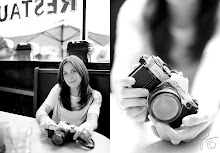Everest Base Camp!!
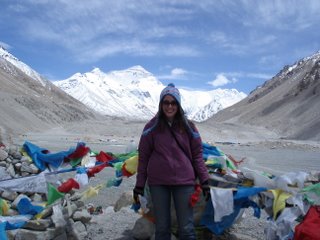 I cannot believe that I have actually been on a mountain, 6,000 meters up. Everest Base Camp was absolutely one of the highlights of my entire trip. Everest itself is stunning from a distance, and becomes even more imposing and beautiful the closer you get.As we drove through mountain passes, climbing up to 5,000 meters, I suddenly felt the effects of the altitude. Arriving at the Rongphu monestary, where we would spend the night sleeping at over 5,800 m, I had a mild headache and it felt like someone was sitting on my chest. After a few deep breaths from the oxygen cans we had brought, I felt better and was ready to start the 7 km trek to Everest base camp.
I cannot believe that I have actually been on a mountain, 6,000 meters up. Everest Base Camp was absolutely one of the highlights of my entire trip. Everest itself is stunning from a distance, and becomes even more imposing and beautiful the closer you get.As we drove through mountain passes, climbing up to 5,000 meters, I suddenly felt the effects of the altitude. Arriving at the Rongphu monestary, where we would spend the night sleeping at over 5,800 m, I had a mild headache and it felt like someone was sitting on my chest. After a few deep breaths from the oxygen cans we had brought, I felt better and was ready to start the 7 km trek to Everest base camp.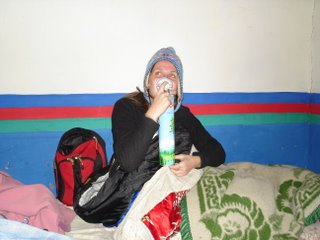 The path to base camp was empty and as we walked, we passed only yaks, prayer flags and a perfectly clear stream. The mountains around us were massive and ahead, Everest looked massive, despite the fact that we were only 2,000 m from its summit. The entire walk I kept my eyes fixated on Everest's summit. It was even more stunning than I could have imagined and I was surprised at the impact it had on me.Base camp itself was nothing too impressive. Divided into two sections, the first portion is a collection of small tents run by local Tibetans. The second section, cut off to anyone not climbing Everest (a $200 US fine if you enter this portion of the camp), is where the actual climb
The path to base camp was empty and as we walked, we passed only yaks, prayer flags and a perfectly clear stream. The mountains around us were massive and ahead, Everest looked massive, despite the fact that we were only 2,000 m from its summit. The entire walk I kept my eyes fixated on Everest's summit. It was even more stunning than I could have imagined and I was surprised at the impact it had on me.Base camp itself was nothing too impressive. Divided into two sections, the first portion is a collection of small tents run by local Tibetans. The second section, cut off to anyone not climbing Everest (a $200 US fine if you enter this portion of the camp), is where the actual climb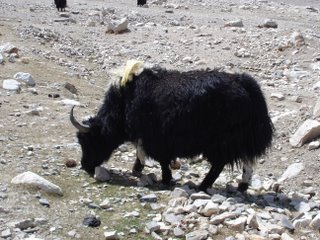 ers are based. Otherwise, base camp is just a large, windy stretch of the mountain, with a view of the summit. We climbed a small hill at base camp to hang some Tibetan prayer flags and spent some time just sitting around in wonder of how high we actually were.Leaving base camp I developed a terrible headache and nosebleed from the altitude. That night was a difficult one because of the altitude and the accommodations. The monestary was basic - to say the least - and the rooms were freezing, despite our sleeping bags. With four of us in the room, all I heard all night was the sound of oxygen being inhaled and people blowing their noses. None of us slept.
ers are based. Otherwise, base camp is just a large, windy stretch of the mountain, with a view of the summit. We climbed a small hill at base camp to hang some Tibetan prayer flags and spent some time just sitting around in wonder of how high we actually were.Leaving base camp I developed a terrible headache and nosebleed from the altitude. That night was a difficult one because of the altitude and the accommodations. The monestary was basic - to say the least - and the rooms were freezing, despite our sleeping bags. With four of us in the room, all I heard all night was the sound of oxygen being inhaled and people blowing their noses. None of us slept.
The next morning, we awoke t o watch the sunrise over the mountain. Leaving, I was struck at the fact that I was sad to go. Over the last few months I have seen so much and passed through so many places that I often don't have time to feel sad when I leave. However, for some reason when I left Everest, all I could think was, "This is the last time I will be here."
o watch the sunrise over the mountain. Leaving, I was struck at the fact that I was sad to go. Over the last few months I have seen so much and passed through so many places that I often don't have time to feel sad when I leave. However, for some reason when I left Everest, all I could think was, "This is the last time I will be here."
Everest was amazing, and despite the small bout of altitude sickness, I still have to say that it was the one of the most incredible things I have ever seen.
Lin-Lin in Lhasa
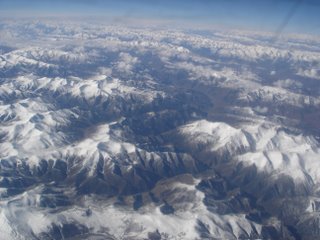 From here on in, I will be known as Lin-Lin.
From here on in, I will be known as Lin-Lin.
Apparently my guide in Tibet had a hard time with the name Della and renamed me Rong-Lin (based on my last name). I am told that Lin means "beautiful Jade" and she gave me the nickname Lin-Lin. I wasn't so sure I liked this name. I believe that one of my university roommates' dogs was called Lin-Lin. Sadly, this name stuck and my travel companions in Tibet - Matthaius, Kep Kep and Leo - all liked it and insisted on using it.
The flight into Lhasa was incredible. With the wind ow seat all I could see to the horizon were giant white mountains. Lhasa itself was beautiful. As we drove into town, the Potala palace - perched on a hill overlooking the town - came into our view and it struck me how strange it was to be in Tibet. Suddenly I felt the distance between myself and everyone at home in Canada.
ow seat all I could see to the horizon were giant white mountains. Lhasa itself was beautiful. As we drove into town, the Potala palace - perched on a hill overlooking the town - came into our view and it struck me how strange it was to be in Tibet. Suddenly I felt the distance between myself and everyone at home in Canada.
Our first day in Lhasa was a quiet one because we needed to acclimatize to the nearly 4,000 meter altitude. I didn't feel the altitude, but Matthaius, Kep Kep and Leo all had terrible headaches and we were all exhausted after the early flight and the drive into the city.
On our second day in Lhasa we first toured the Potala palace. It was filled with hundreds of giant golden Buddhas and other Tibetan buddhist shrines. The best part was that the palace is a living monestary and temple. While walking around we were pushed aside by Tibetans who were making offerings to the various Buddhas and stupas. They prayed, lit candles and made offerings of money to the Buddhas they saw. Outside, groups of pilgrims pushed the prayer wheels and threw themselves on th e ground in prayer.
e ground in prayer.
We then visited the Jokhang Temple/Monestary. Located in the middle of town, large groups of monks dressed in heavy maroon robes sat around in groups. We were told that these monks had come from all over Lhasa to debate issues related to Buddhism and to sit exams. Inside the monestary, we were lucky to see the arrival of a high-ranking Lama. The monestary was shut to visitors, but since we were already inside they permitted us to stay. Monks were dressed in their full outfits, including their hats, and had decorated the courtyard with paintings of Buddhist symbols. As the Lama arrived, they played their horn and rushed over to greet the old man.
The rest of our time in Lhasa was spent wandering the Barkhor market that surrounds the monestary. Pilgrims circle the monestary in prayer and along the circuit there are vendors selling everything from clothes to stuffed yaks. 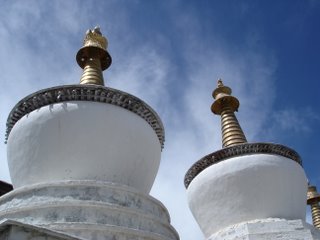 The next morning we set out for a long drive through mountains and past green rivers to Shigatse, the home of the Panchen Lama. We again toured beautiful, ornate monestaries and I learned a lot about the Tibetan Buddhist religion. Our next day was an epic drive, offroading in our 4X4 through dirt paths, across streams and rivers and through tiny Tibetan villages filled with identical whitewashed homes. Arriving in Tingri, just a short distance from Everst, we were surprised to see that it was just one road lined with shops and a handful of guesthouses. The scenery of Tibet is gorgeous and the closer we got to Everest, the more exicited the group of us got, despite the fact that it was colder and the altitude higher, causing some of us to be sick.
The next morning we set out for a long drive through mountains and past green rivers to Shigatse, the home of the Panchen Lama. We again toured beautiful, ornate monestaries and I learned a lot about the Tibetan Buddhist religion. Our next day was an epic drive, offroading in our 4X4 through dirt paths, across streams and rivers and through tiny Tibetan villages filled with identical whitewashed homes. Arriving in Tingri, just a short distance from Everst, we were surprised to see that it was just one road lined with shops and a handful of guesthouses. The scenery of Tibet is gorgeous and the closer we got to Everest, the more exicited the group of us got, despite the fact that it was colder and the altitude higher, causing some of us to be sick.
Panda-mania in Chengdu
 Do you remember the sex ed video from grade 9 gym class called "The Miracle of Birth"? For those of you who haven't seen it, it's a dated educational video that features, above all else, a disturbing close-up of a live birth. It had the effect of inducing groans of "ewwwww gross!" and "ouuuuchhhhh!" from the group of 14-year-old girls in my gym class and, at least briefly, had us all pledging to never have sex. It was a dose of video birth control.
Do you remember the sex ed video from grade 9 gym class called "The Miracle of Birth"? For those of you who haven't seen it, it's a dated educational video that features, above all else, a disturbing close-up of a live birth. It had the effect of inducing groans of "ewwwww gross!" and "ouuuuchhhhh!" from the group of 14-year-old girls in my gym class and, at least briefly, had us all pledging to never have sex. It was a dose of video birth control.
I was again reminded of this film, as I sat through the panda equivalent of it at the Panda Breeding Centre in Chengdu, China. And if I ever wondered why pandas were an endangered species, I don't anymore after seeing this disturbing video.
 I watched in disgust as a gross, pinkish, alien-looking creature shot out of the mother panda's vagina and began screeching in a violent way. This caused the mother panda to literally jump across the cage in fear (I think that I would do the same if that thing suddenly shot out of my vagina). Panicking, and apparently unable to identify this rat-like animal as its offspring, the mother began violently batting the baby panda around the cage like a beachball before it was saved by the centre's caregivers. The video informed us that this is apparently a common reaction because most females are surprised when they give birth the first time. No wonder so few pandas exist in the wild.The pandas themselves were quite cute. I spent the morning watching them in their enclosures eating bamboo, sleeping and even take a shit. Apparently they don't do much more than that. Sometimes they have sex, which the Chinese always refer to as "panda marriage", as if though the panda, like humans, should be incapable of reproducing unless they are married. I didn't see any live panda sex shows, but t
I watched in disgust as a gross, pinkish, alien-looking creature shot out of the mother panda's vagina and began screeching in a violent way. This caused the mother panda to literally jump across the cage in fear (I think that I would do the same if that thing suddenly shot out of my vagina). Panicking, and apparently unable to identify this rat-like animal as its offspring, the mother began violently batting the baby panda around the cage like a beachball before it was saved by the centre's caregivers. The video informed us that this is apparently a common reaction because most females are surprised when they give birth the first time. No wonder so few pandas exist in the wild.The pandas themselves were quite cute. I spent the morning watching them in their enclosures eating bamboo, sleeping and even take a shit. Apparently they don't do much more than that. Sometimes they have sex, which the Chinese always refer to as "panda marriage", as if though the panda, like humans, should be incapable of reproducing unless they are married. I didn't see any live panda sex shows, but t here were photos of panda porn on signs scattered throughout the park, many of them including graphic descriptions of panda mating habits.
here were photos of panda porn on signs scattered throughout the park, many of them including graphic descriptions of panda mating habits.
So you are of course wondering where pandas now rate on my animal scale. Well, it's still penguins at #1, but pandas come in a close second (namely because none of them attacked me or farted on me), with camels and monkeys rounding out the end of the list.
I Met My Boyfriend at IKEA Tokyo
 Yes, that is a photo of me and a Japanese man who is either asleep, but more likely drunk (note the beer).
Yes, that is a photo of me and a Japanese man who is either asleep, but more likely drunk (note the beer).
Now, a sleeping or drunk Japanese man is not particularly noteworthy on his own. They are always sleeping or drunk on the subway here. However, what is of interest is that the photo of the passed out man was taken at IKEA in Japan. Not the ideal place to get trashed, but he seemed to be enjoying it.
Sandra, Jay and I decided to visit Japan's first IKEA the week it opened. Talking to a staff member, we were told that at 9:30 am the day of the store's grand opening, not a single person was in line. He admitted that at that point IKEA executives began to panic, but they were relieved when at 9:50 am over 4,000 were in line. By end of day one over 35,000 IKEA-loving Japanese had cruised through the store.
Now, you're probably asking why we went to IKEA since we have IKEA in Canada. Mainly we went because I love any opportunity to watch the Japanese whip themselves into anything resembling a fury. Strangely, this never seems to happen. Calm and compliant behaviour is the norm here, but I must say that the IKEA experience was as close as I have seen any of the Japanese get to any sort of frenzied behaviour. I guess that cheap furniture does that to people, especially in a country where it is not uncommon to pay $300 (Cdn.) for two gift melons.
I was also excited to see if IKEA in Japan was any different than IKEA in Canada, and I was pleasantly surprised to see a nice mix of consistency and differences.
Things That Are EXACTLY the Same at IKEA Japan and IKEA Canada 1. Snake Pit - Scary oversized stuffed snakes that make you wonder who buys these things.
1. Snake Pit - Scary oversized stuffed snakes that make you wonder who buys these things.
2. Same Old, Same Old - Same couches, tables, curtains, shelves and accessories.
3. But All I Wanted Was a Candle... - Same oversized bags for you to carry all the crap that you didn't mean to buy when all you really wanted was a throw pillow, a cool dish and a few Swedish meatballs. Like you REALLY needed that blanket that doubles as a dart board.
4. Getting Lost - The mazelike layout, including arrows to direct people (not required because the Japanese are not prone to trying to "go against the flow" in any sense), ensure no escape until you've seen the whole store.
Things That Are KINDA the Same at IKEA Japan and IKEA Canada...But Not Really1. Kiddie Holding Pen - Known as the ballroom in Canada, in Japan it is called Smiletown. Basically the two are the same -one room filled with screaming children jumping in vats of large plastic balls which are probably coated in a thin layer of urine.
I am also sure that, just like in Canada, in Smiletown there is at least one six-year-old girl stealing balls, frantically stuffing them into her snowsuit when staff members aren't looking, because her father told her that, "If every time we go to the IKEA ballroom you take at least one ball home with you, soon you will have your own ballroom in the basement." Oh wait...maybe that was just at the Nepean IKEA...DAD!
Being a ballroom connaiseur myself, I thought that the Japanese room was nicer, primarily because it is new and likely relatively urine-free...for now.
2. IKEA Loonie Dogs - In Japan these things cost 100 Yen, which is the equivalent of a Canadian dollar. This is where the similarity ends. I had to buy a ticket from a small vending machine-like device to exchange for the 100 Yen Dog. I then had to proceed to strange ketchum and mustard dispensing udders that hung from the ceiling.
And yes, this thing looked absolutely disgusting but -this will come as no surprise to those who know me well enough to know that I am always eating - I ate it anyway because I was hungry.
3. IKEA cafeteria - Just like at home, the IKEA Japan cafeteria serves up what I assume is Swedish comfort food, including Swedish meatballs, salmon and reindeer (ok fine, no reindeer, but that's what I picture the Swedes eat every day at home).
In the Ottawa and Toronto stores the cafeterias are relatively small, but in Japan the cafeteria is enormous. The day we were there it was filled with young Tokyo-dwellers chowing down on full meals of Swedish foods- meatballs, rice, potato, salad, buns, deserts and beer?? Since when do people drink at IKEA? And who would think of drinking so much there that they actually passed out?
In Canada I always thought of the IKEA cafeteria as a place where people stopped only if they became lost in the store, stopping briefly for directions to the exit and to eat meatballs to restore their energy for the marathon trek out. In Tokyo the people we saw seemed genuinely excited for a full IKEA meal and didn't seem to mind spending money to get it (soooo expensive!!). In Japan, I guess that Swedish food is hip. In fact, I actually think some people came to IKEA just for the cafeteria food. Since when did it become cool to eat at IKEA?
Things That Are TOTALLY Different Between IKEA Japan and IKEA Canada
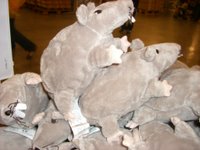 1. IKEA Japan Fornicating Stuffed Rats - Not sure why stuffed rats would be a big seller at IKEA in Japan, especially when positioned having sex in a large bin of other stuffed rats...like a stuffed rat orgy.
1. IKEA Japan Fornicating Stuffed Rats - Not sure why stuffed rats would be a big seller at IKEA in Japan, especially when positioned having sex in a large bin of other stuffed rats...like a stuffed rat orgy.
I also wonder why we don't have them in Canda. I assume this item did not test well in the Canadian market. Parents' comments probably included feedback like, "Humping rats are not ideal toys for my child!" or "The new IKEA Kaamoi Suitraa Rats are not funky enough for my kid."
 I cannot believe that I have actually been on a mountain, 6,000 meters up. Everest Base Camp was absolutely one of the highlights of my entire trip. Everest itself is stunning from a distance, and becomes even more imposing and beautiful the closer you get.
I cannot believe that I have actually been on a mountain, 6,000 meters up. Everest Base Camp was absolutely one of the highlights of my entire trip. Everest itself is stunning from a distance, and becomes even more imposing and beautiful the closer you get.
 ers are based. Otherwise, base camp is just a large, windy stretch of the mountain, with a view of the summit. We climbed a small hill at base camp to hang some Tibetan prayer flags and spent some time just sitting around in wonder of how high we actually were.
ers are based. Otherwise, base camp is just a large, windy stretch of the mountain, with a view of the summit. We climbed a small hill at base camp to hang some Tibetan prayer flags and spent some time just sitting around in wonder of how high we actually were. o watch the sunrise over the mountain. Leaving, I was struck at the fact that I was sad to go. Over the last few months I have seen so much and passed through so many places that I often don't have time to feel sad when I leave. However, for some reason when I left Everest, all I could think was, "This is the last time I will be here."
o watch the sunrise over the mountain. Leaving, I was struck at the fact that I was sad to go. Over the last few months I have seen so much and passed through so many places that I often don't have time to feel sad when I leave. However, for some reason when I left Everest, all I could think was, "This is the last time I will be here." From here on in, I will be known as Lin-Lin.
From here on in, I will be known as Lin-Lin.








